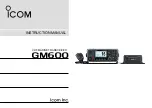
Sensing and Internet of Things
11
Installation and Technical Manual for the
Limitless™ Multi-Protocol Receiver, WMPR Series
ISSUE B
32309669
5 | SETUP AND
ELECTRICAL CONNECTIONS
m
WARNING
RISK OF ELECTRICAL SHOCK
Potential shock hazard where HAZARDOUS LIVE voltages
greater than 30 Vrms, 42.4 V peak, or 60 Vdc may be accessi-
ble.
Failure to comply with these instructions could result in
death or serious injury.
m
WARNING
Pay attention to ESD discharge at dc-in port.
,
ATTENTION
Do not run the electrical wires in parallel and close proximity
to the antenna or antenna cable.
5.1 | System Set Up
5.1.1 | WMPR EDS File
The WMPR Series needs to connect to an EtherNet/IP™ com-
pliant Master device and thus the Electronic Data Sheet will
need to be uploaded to the Master device (Contact Honeywell
for this file; refer to REFERENCE on page 1 in the document for
file number).
This file allows the unique MAC ID of the WMPR to be associat-
ed to the parameters in this file. To view and obtain the MAC ID
of your device refer Section 6.1.1, Figure 5.
5.1.2 | WMPR Object Model
The WMPR Object Model describes the different object models
supported as well as bytes and attributes in detail. (Contact
Honeywell for this file; 32308916).
The key attributes that most customers are interested in are
Digital Input State, Analog Input Value with Unit Type, Battery
Level and Radio Signal Strength. The descriptions relative to
Limitless™ Series of product are as follows for each:
Digital Input State:
The wireless switch actuation state is ei-
ther ON or OFF for a WLS, WGLA, WOI and WBX Series switch.
Analog Input Value with Unit Type:
Pressure reading from a
WPS Series sensor in psi, bar, mbar, Pa or kPa.
Battery Level:
The battery condition is either OK or LOW. A
LOW condition normally indicates the battery life is coming to
an end and the battery should be replaced as soon as possible.
Radio Signal Strength:
This attribute identifies the level of
signal strength between the WMPR and the Limitless™ switch
or sensor.
Table 13. Conformance Advisories & Warnings
Test Item
Advisories: Ob-
served WMPR
Behavior
Required Behavior
and Specification
Reference
EDS File Test
Advisory: One or more
connection path(s) declared
in EDS file do(es) not match
connection path(s) declared
in STC file
Ethernet Link
Object Tests
Advisory: Successful
auto-negotiation reported
when testing PC is in forced
duplex mode
[Vol. 2 Ed 1.17] Interface
Flags 5-5.3.2.2
Interface
Configuration
and Subnet Test
Cases
Warning: DUT can only
operate as a
class C network when
its IP address is set to
192.168.x.x. All other IP
address ranges behave
correctly.
DUT should be able to work
with all types of IP addresses
on a class A, B or C network.
Refer to RFC950 for a
detailed explanation.
5.2 | Static IP Address (Turn ON/OFF DHCP
Server)
The WMPR (Gen code 2 ONLY) allows configuration control
to set a static (permanently assiged) IP address. An example
of this feature being necessary is when the WMPR is used in
a closed loop/dedicated control system and a DHCP server is
not available. A static IP address is easy to establish by “turning
OFF” the DHCP server requirement via a menu choice within
the WMPR. The method to turn the DHCP server ON or OFF
with further detail can be found in Section 6.13.
5.3 | EtherNet/IP™ Output Connection
5.3.1 | Description
The Limitless™ WMPR Series has a RJ45 ethernet jack on the
housing’s bottom left which needs to be connected to Cat5e
or Cat 6 cable (dependant n application conditions) that then
connects to the EtherNet/IP™ compliant Master device. Refer
to the EtherNet/IP Media Planning and Installation Manual
(Pub 148) for more information at www.odva.org.
,
NOTICE
Power needs to be applied after the EtherNet/IP™ connection
has been made and is active.
















































